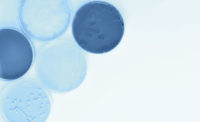Microbial Degradation of Water-Based Pigments

Water-based pigments are susceptible to microbial attack. In general, all organic pigments are utilized by different bacteria as a source of carbon and nitrogen. Among all pigments tested, yellow pigments are more susceptible to bacterial degradation because of their organic origin. In a successional event, bacteria serve as first colonizers, followed by the growth of fungi, leading to spoilage of pigment paste. This spoilage is observed as a foul odor due to the generation of low-molecular-weight degraded compounds and sulphides, and discoloration and viscosity increase due to a precipitation reaction caused by bacteria.
Bacterial degradation occurs in two main stages, which is eventually taken over by fungal growth. In the first stage, waterborne bacteria or pigment-associated bacteria play a major role. This group of bacteria, mainly represented by Pseudomonas, Proteus, Enterobacter and Citrobacter, act as primary degraders. One hypotheses is that these bacteria may secrete exogenous enzymes to degrade pigment and other components like lecithin and surfactant molecules, and carry out a fermentative reaction that causes gas formation, foul odors and pH decrease. In the second phase of pigment spoilage, bacteria such as Staphylococcus utilize the metabolic by-product formed and cause a precipitation reaction by secreting lecithinase enzyme on the lecithin, which causes non-reversible viscosity increase and a pungent odor. To avoid this degradation of pigment paste, the following preventive measures should be in place.
Raw Material Microbial Load Check
Many hygiene audits performed worldwide have observed pigment powders contaminated with gram-positive spores and some gram-negative bacteria. Yellow and green pigments are found to be contaminated most frequently. Also water has been found to be contaminated and can serve as an excellent source for primary contaminants and degraders. Although lecithin by itself does not add any contamination, it can play a major role in viscosity pick up if the final product is contaminated by lecithinase-producing bacteria. Water has also been observed to be a source of contamination. Gram-negative bacteria mostly prevail and contaminate the final product with primary degraders. These bacteria also have a tendency to develop resistance against commonly used biocides.
Equipment Hygiene
Improper equipment cleaning also plays a major role in adding contaminant in the pigment paste. The stored water, even RO (reverse osmosis) water, has the potential to develop microbes if stored for long. When this water is used to wash premixing tanks or storage tanks, it eventually adds to product contamination. Better hygiene practice may improve product resistance to microbial degradation up to 20-30%.
Storage Before Production is Completed
Many pigment manufacturers try to store intermediate products before the finish line. This gives bacteria an opportunity to multiply and become more than actual estimates – posing a practical challenge to determine the correct biocide concentrations.
Incorrect Biocides in the Product
Pigment degradation is a result of enzyme actions secreted by microbes. Therefore, it is important to check the enzyme activity as soon as the product reaches the finish line. Once lecithinase is active in the product, the precipitation reaction becomes faster and forms a cascade reaction that is unavoidable and irreversible. Commonly used preservatives like CMIT/MIT act on the membrane system and check the cell division by reacting with thiol groups, and their efficacy on enzymes like lecithinase is not known. The preservatives that solely work on formaldehyde release also are not very effective at permissible doses. The best possible remedy is to use a preservative that has an enzyme deactivation activity along with biocidal activity.
Testing Protocols
Before starting in-can efficacy testing using fouled pigment slurry containing test biocides, one has to make sure that the fouled material (spoiled product or water) should have all types of bacteria that serve as various links in the succession event of product spoilage. Many times spoiled material and heavily fouled water serve only second phase bacteria and therefore remain ineffective for demonstrating viscosity pick up and fouling. Preservatives used to determine efficacy will not give correct estimates of potency and doses.
Conclusion
For yellow pigments, CTAC chemistries have been found to be most effective at the lowest doses (0.1% or less) because they don’t work solely on formaldehyde-based killing. They may deactivate the enzyme lecithinase that is responsible for viscosity pick up and control bacterial growth. DBNPA chemistry also reacts with enzyme and kills 99.9% of bacteria, but it degrades quickly, meaning it doesn’t remain in the system for long (more than 48 hours), and the microbial growth returns to the system rapidly. Robust biocides, better hygiene and the right testing protocols can bring expected shelf life in water-based pigments.
Looking for a reprint of this article?
From high-res PDFs to custom plaques, order your copy today!








